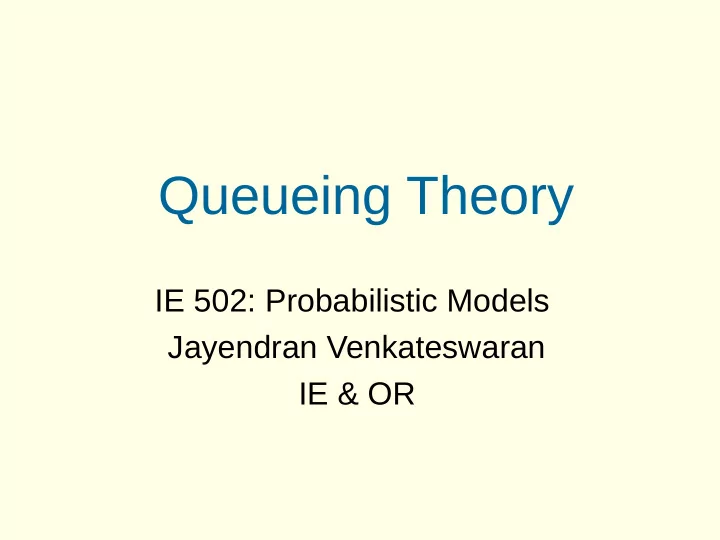

Queueing Theory IE 502: Probabilistic Models Jayendran Venkateswaran IE & OR
Typical Configurations Server Customer Customer Departs Arrives Server Customer Server Departs Customer Arrives Customer Server Departs Key Attributes Service times, Calling Arrivals Queue capacity; Capacity population pattern Queue discipline IE502: Probabilistic Models IEOR @ IITBombay
Analytical Models of Queues • Queueing Theory was developed by A.K. Erlang in 1909. – Worked for Copenhagen Telephone Exchange as an engineer, and developed tools to analyze and design telecommunication networks based on probability theory. IE502: Probabilistic Models IEOR @ IITBombay
Standard notation • Standard notation to identify the main elements that define the structure of a queueing system is (first suggested by D.G. Kendall, 1953) : M G 1 Arrival Process M: Markovian Queue discipline D: Deterministic FIFO: First in First Out G: General LIFO: Last in First Out Max capacity E K : Erlang etc (or buffer size) Default value: FIFO of system. Service time distribution Default : ∞ M: Markovian D: Deterministic Size of source G: General Number of Servers Default: ∞ E K : Erlang in Parallel IE502: Probabilistic Models IEOR @ IITBombay
M/M/1 • M/M/1 queueing system is a Birth & Death process characterized by having the arrival rates λ and the service rates µ independent of the state. • Usual picture of M/M/1 queue λ μ • State space representation of M/M/1 queue • What is the limiting probabilities P n for M/M/1? P n : long run probability that system contains exactly n customers IE502: Probabilistic Models IEOR @ IITBombay
M/M/1: ρ versus P i • How do you interpret the figure below? ρ=0.2 ρ=0.5 ρ=0.8 P i i IE502: Probabilistic Models IEOR @ IITBombay
Performance Measures of M/M/1 • We are typically interested in the steady state performance measures: – Server Utilization, U – Expected number of customers in the system, L – Expected number of customers in the queue, L Q – Average time a customer spends in the system, W – Average time a customer waits in the queue, W Q • Before we look at further performance measures of M/M/1 queue, let take a look at Little’s Law. IE502: Probabilistic Models IEOR @ IITBombay
Little’s Law • First proof published by John D.C. Little (1961) Little’s Law In steady state, the expected number of entities in the system is equal to the average arrival rate multiplied by the expected time spent in system – Avg Number in sys = Avg Arrival rate x Avg time in sys – Avg Number in sys = Avg Departure rate x Avg time in sys – Avg Inventory = Avg Throughput rate x Avg Flowtime – Avg WIP = Avg Throughput rate x Avg Flowtime • Let’s look at an illustrative proof of Little’s Law IE502: Probabilistic Models IEOR @ IITBombay
Proof of Little’s Law What are the Number in assumptions system we have N ( t ) made? time t Arrivals Departures T 2 T 1 IE502: Probabilistic Models IEOR @ IITBombay
Little’s law in practice 1. KanjurMarg ticket counter can serve up to 100 customers per hour. The queue for the counter has 30 people in it. How long will you spend in the queue? 2. KReSiT tea shop sells 50 litres of tea per day. The manager wants the tea to be always fresh, i.e., the tea should not be more than 2 hours old on the average when sold. How much tea should be made & stored? (Assume 10 hr per day) IE502: Probabilistic Models IEOR @ IITBombay
Coming back to M/M/1 queue • The steady state performance measures of M/M/1 queue: – Server Utilization, U – Expected number of customers in the system, L – Expected number of customers in the queue, L Q – Average time a customer spends in the system, W – Average time a customer waits in the queue, W Q IE502: Probabilistic Models IEOR @ IITBombay
Recommend
More recommend